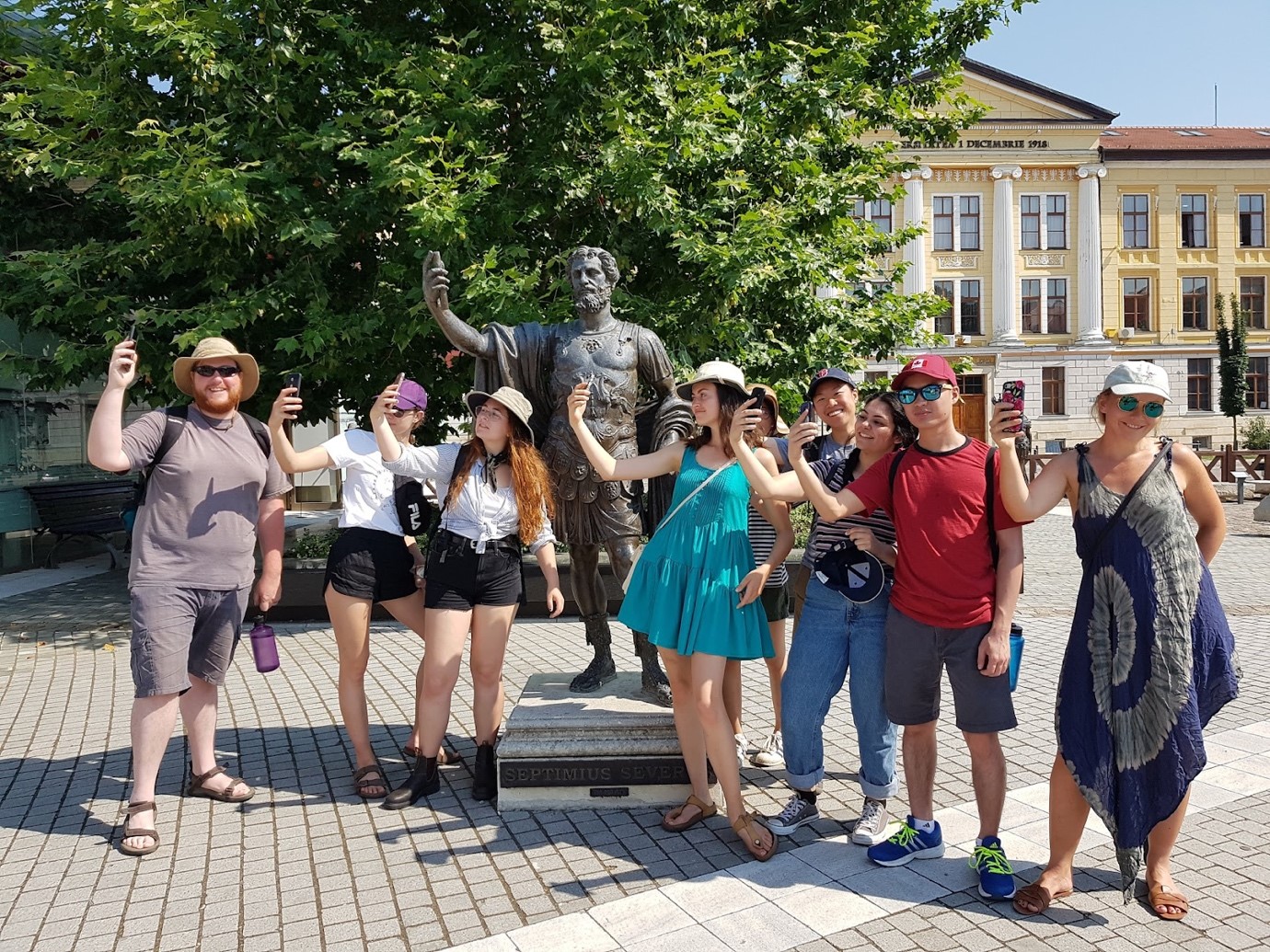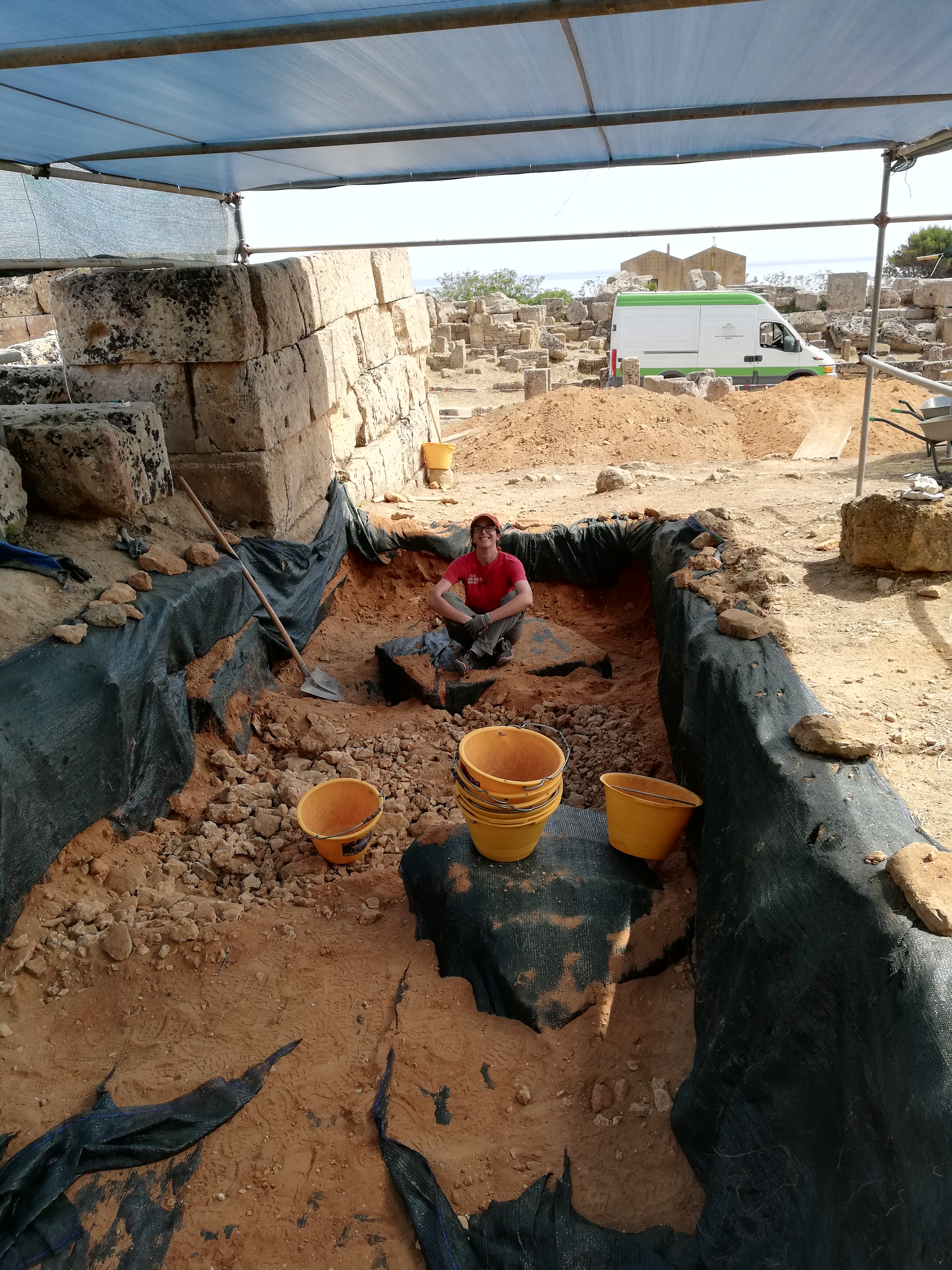CNERS graduate and undergraduate students excavated in Romania in summer 2019.
On July 24, an eager team of Canadian and Romanian students and archaeologists made their way to the small city of Alba Iulia, nestled in the heart of Transylvania. CNERS graduate students Dora Gao, Lindsay Fraughton, Emma Ramsden, Allison Marlyn, Matt Naylor, Amber Leenders joined undergraduate students Hannah Cavers, Ashley Samsone, Lorrieya Zhang, Kevin Lam, and Ailsa McFadyen under the direction of Dr. Matthew McCarty and his Romanian co-directors Mariana Egri and Aurel Rustoiu. This was the very first season of the Apulum Roman Villas Project. We worked hard that month to excavate and record the complex architecture and soil, as well as process our finds and make 3D models of our trenches. The team ate at the local restaurant Steakhouse, where the owner Vlad not only served up hearty dishes of Romanian cuisine, but sometimes also supplied wine and pálinka—a strong plum liquor that one should drink in moderation.
On our days off, we toured sites including Dacian hillforts, the Roman city Ulpia Traiana Sarmizegetusa, and the medieval town of Sighisoara. No vampires were sighted, although we did keep an eye out for them. We also had two unexpected teammates: the boisterous stray dogs Shaun and Balto. After a couple vet visits and some regular meals, they were inseparable from our team. So inseparable, in fact, that Dora actually got a puppy passport for Balto (who now goes by Zeke!) and gave him a new home in Vancouver!
For more project updates and pictures from our 2019 season, please visit the ARVP blog.
Gillian Glass, PhD Religious Studies candidate, spent the 2018/19 academic year studying at École Biblique in Jerusalem.
Stepping off of Nablus Road, through a small door in a large, stone wall, and into the courtyard of the École Biblique is to step back through time. As the door snaps shut behind you, the noise of the city is replaced with bird song and furtive voices of men reciting prayers older than the walls that hear them. The convent has one main feature: quiet. The cloister is almost always empty, the Basilica of St. Stephen a vaulted void, and the sprawling, untamed yard is almost exclusively the domain of birds and bees. While there are regular interruptions of amplified sound—the daily prayer cycle, the student choir at Christmas Mass, the candlelit vigil on Good Friday—the most memorable feature of a year spent in the École Biblique in Jerusalem is, for me, the quiet. One can feel here the silent struggle to maintain a tradition in the face of an ever changing world. This quiet grasps at a bygone era, snatches at a world rapidly fading. In this way, the École Biblique is not all that different from many other corners of Jerusalem. The quiet of the École reaches out to the calm of Shabbat in West Jerusalem, and to the Friday lull in East Jerusalem. In a city as chaotic as Jerusalem, the silence can be deafening.
I spent the last year at the École Biblique in Jerusalem, Israel. This was made possible through the generous support of the Canadian Friends of the Ecole Biblique.
Justin Dwyer, PhD Classics candidate, is spending the 2019/20 academic year at the Canadian Institute in Greece.
I am the 2019-2020 Neda and Franz Leipen Fellow at the Canadian Institute in Greece. While in Athens, I am conducting an analysis of small-scale terracotta sculpture from collections in Karystos, Eretria, Chalkis, and Athens. This research will help me build a diachronic model of the Euboean dramatic tradition, taken in conjunction with the epigraphic record and the evidence for the early phases of the theatre at Eretria. This model will provide a useful new lens for interpreting individual fragments and in identifying the uniquely Euboean elements Apollodoros of Karystos brought to the genre of Athenian comedy. In my spare time, I have been attempting to cook traditional Greek dishes and have so far made edible horiatiki, horta, and gemista with ingredients from the local laiki.
Kate Minniti, PhD Classics (Classical Archaeology) candidate, excavated in Sicily in summer 2019.
From the end of May to the beginning of July 2019 I was once again a staff member of the NYU-UniMi excavation on the acropolis of Selinunte, Sicily. The expedition is investigating the area of the urban sanctuary of the city, containing the most ancient Greek temple of the site, Temple R, dedicated in 590-580 BCE to a still unspecified goddess (the most likely candidates are Demeter and Artemis). Our first trench unearthed the layers associated with the construction of this building, and revealed that the area was used for sacred rituals even before the construction of the first stone building. The second trench clarified the relationship between Temple R and its massive neighbor, Temple C, built between 540 and 510 BCE, and gave us precious insights on the latter’s construction technique.
The season’s most important finds were the foundation trench of Temple C, and a structure predating Temple R by at least a decade containing spearheads, ceramics, and the remains of a sacrificed bull. An even earlier layer in the same area uncovered the antlers of a deer. We also discovered a votive deposit associated with Temple R containing, among other things, a beautiful faience figurine of a falcon.
Lisi Schrottner, MA Religious Studies student, visited Israel in summer 2019.
In June 2019, I had the privilege of travelling to Israel for a short research and study trip. I spent most of the two weeks in Jerusalem, checking out sites that are relevant to my research on the Dead Sea scrolls and the late Second Temple period. On the first day, I went to the archaeological site of Qumran and was finally able to see the caves where the scrolls were discovered in 1947. But one of the highlights of the trip was actually seeing the scroll that I’ve been researching for the past year! I hadn’t planned this before arriving, so I am indebted to Dr. Orit Peleg-Barkat of Hebrew University for setting up the meeting while in Israel. When I went to the Israel Museum in Jerusalem, I received permission to enter the adjoining Israel Antiquities Authority office and I spent an hour with my fragmentary manuscript, the Samuel Apocryphon (4Q160). The experience of sitting with a 2100-year-old manuscript, in the room where conservators have worked for decades to preserve the scrolls, was amazing! The staff was very helpful and even lifted fragments off their mount so that I could closely inspect the text and the leather degradation. And the excitement didn’t end there! I was taken to the rooms where the entire collection (900+ manuscripts) has been photographed and digitized, and met the scholars working on the project. I am incredibly grateful to the staff at the Dead Sea Scrolls Project and Digital Library for granting me the privilege of observing their workspace.


MA student Lisi Schrottner examining the original Dead Sea Scroll she’s been researching for her thesis. Photo: Tanya Treiger, Israel Antiquities Authority.
Amber Leenders, MA Classical and Near Eastern Archaeology student, visited Yale to see Dura Europos collections in summer 2019.
In June of 2019, I was fortunate enough to travel to New Haven, CT, and spend a week doing research at the Yale University Art Gallery Archives. Not only was I supported by the CNERS department, but I was also warmly welcomed by the curators of ancient art at the gallery: Lisa Brody, Susan Matheson, and Megan Doyon. It was incredible to see their exhibit on the site of Dura-Europos, which is the topic of my thesis. My goal is to reinterpret two of the polytheistic temples at Dura using archival data from the early 20th century excavations, carried out by Yale University and the French Academy of Inscriptions. Since Yale houses an extensive archive of the excavation materials, I was able to read the directors’ original field notebooks, discover previously unpublished pictures, and find catalogues of artifacts from the temples. This research gave me more data and a fresh perspective that has helped me immensely in my writing. Although the archives kept me busy, I had some spare time during the week to see dinosaurs and cuneiform tablets at the Peabody Museum of Natural History, admire the marble architecture of the Beinecke Rare Books Library, and eat delicious crepes in downtown New Haven.


MA student Amber Leenders at the Yale Gallery and Archives where she was able to look at documents in the Dura-Europos archives as part of her thesis research.







